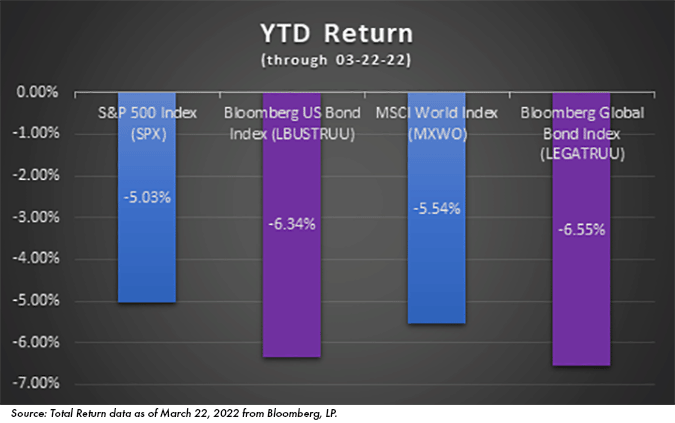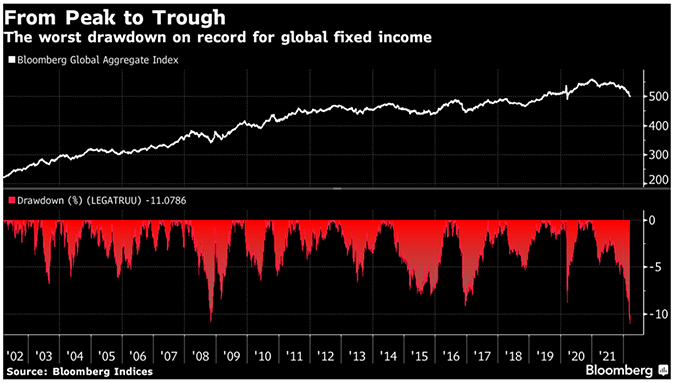CKBlog: The Market
Wednesday, March 23, 2022
Bonds are Down More Than Stocks
by Steve Haberstroh, Partner
Inflation is soaring. Oil and gas prices have spiked. Interest rates are rising. Putin is invading a sovereign country. Stocks are well off their all-time highs. Bonds should be higher right? Wrong.
In fact, not only have bonds not offered protection against the stock market sell-off, they are down even more. The graph below depicts the year-to-date performance of the major stock market indexes (blue) next to the major bond market indexes (purple).

Throw out the text books. Bonds have lost their safe haven status. What is going on?
Bonds are Risky
We’ve been commenting for several years now that bonds have been carrying significant risk. After decades of being conditioned to believe bonds are always safer than stocks, we felt that investors seeking safety in bonds—especially those with longer maturities—were in for a rude awakening.
Calling bonds risky may sound misguided. After all, we’ve always been told:
Want income? Look at bonds.
Worried about a stock market sell-off? Look at bonds.
Geopolitical risks? Look at bonds.
So what changed? Action (and signaling) from the Federal Reserve (and their counterparts abroad). Interest rates are on the rise, countering the trend in place since interest rates peaked in the early 1980s. See below from JP Morgan:

What is clear from the chart above is that rates have been on a steady decline for years. When rates move lower, current bond prices move higher. Why? Consider your parent or grandparent who bought a 10-year bond in September 1981 when its coupon paid them nearly 16% per year. Just five years later, 10-year bonds were yielding less than 10%. The 1981 vintage was far more desirable, so investors were willing to pay more to hold the older paper. True to form, in the 41 years from end of February 1981 to end of February 2022, the Bloomberg US Bond Index delivered a +7.35% annualized return. Rates down, bond prices up.
Of course, the opposite is true. During the global shutdown in 2020, US 10-year bonds were yielding 50 basis points. Apparently, investors were willing to be paid one-half of one percent for the subsequent 10 years. I suppose a global pandemic will do that to you. Good luck trying to sell that same paper to an investor today when the current US 10-year note yields 2.3% per annum—more than four times 2020 levels. As rates move higher, current bond prices move lower.
You can see the impact of rising rates on global bond prices on chart below. The red depicts drawdowns from most recent highs. The current drawdown of -11% is the highest since 1990 which includes the Financial Crisis. Ouch.

So here we are today. Since the beginning of the year, a classic 60% stock, 40% bond portfolio is down more than a 100% stock portfolio. Those who positioned themselves more conservatively at say, 20% stocks and 80% bonds, are down even more. The largest bond ETF in the world, the iShares 20+ Year Treasury ETF, is now down 12.93% year to date through today.
The paradigm has shifted. If rates continue to rise (as most expect and the Fed has signaled), bonds will continue to suffer. If you feel like the stock market is too risky and have sought refuge in bonds, this post may cause you anxiety. Don’t panic. If you cannot navigate the current environment alone, seek an advisor who has lived through periods of rising rates. If you need help finding one, I’ll send you my father’s cell number.*
Here is the PDF version of Bonds are Down More Than Stocks
*Note: Charles Haberstroh, our CIO (and my father), lived and invested through high interest rates in the 1970s and 1980s as well as the hyperinflation while living in Brazil during the mid to late 1980s.




